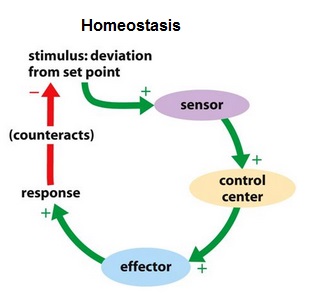|
Figure showing the excercise homeostatic control in a biological system such as our body. (Courtesy: http://biology4alevel.blogspot.ca/2015/09/108-homeostasis-in-mammals.html) |
Homeostasis is a central organizing principle of physiology and refers to the maintenance of a relatively stable internal environment. Put simply, it is the mechanism by which organisms maintain themselves as they are affected by the internal and external environment. It is an automatic control mechanism achieved through the effects of different organ systems working together to return the organism to its equilibrium state.
However, equilibrium is capable of changing with time. For example, an individual may move from living by the sea where there is ample oxygen supply to living up in the mountains where the availability of oxygen is more limited. Since the set-point of oxygen availability is different, the individual experiences acclimatization – an environmentally induced change in physiological function with no genetic change. Circadian rhythms are daily biological rhythms such as sleep-wake cycles and hormonal cycles that can change with physical factors such as relocation or internal factors such as stress. Even so, the body is capable of adapting to these changes, and thus raising the notion of homeodynamics. This word better describes the need for constancy as the organism changes, both in response to its own internal growth and also any environmental influences.
Breathing is the body’s way of maintaining equilibrium between oxygen and carbon dioxide. An inhalation triggers the sympathetic nervous system to release small amounts of cortisol because of the respiratory stress of the carbon dioxide reserve. The parasympathetic nervous system then initiates exhalation so that carbon dioxide is released and blood can be oxygenated. The rate of respiration is ever-changing, affected by consciousness, stress, and mood among others.
The ability of the autonomic nervous system to regulate breathing in the midst of change is homeodynamic. Learning deep breathing techniques allows an individual to practice exercising control over homeodynamic respiration, which ultimately upregulates the control of body function and allows us to survive change.
Related Video:
MIT RES.TLL-004 Concept Vignettes
View the complete course: http://ocw.mit.edu/RES-TLL-004F13
Instructor: Leah Okumura
This video discusses negative and positive feedback loops, how they tie into the body's mechanism of internal regulation, and what happens when these mechanisms fail.
License: Creative Commons BY-NC-SA
More information at http://ocw.mit.edu/terms
More courses at http://ocw.mit.edu
